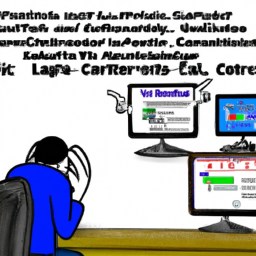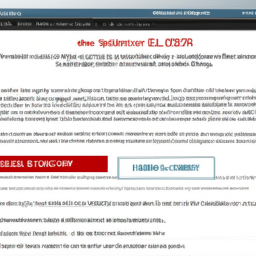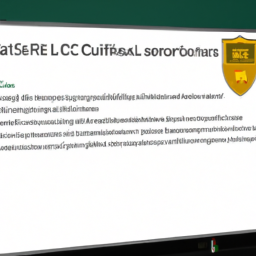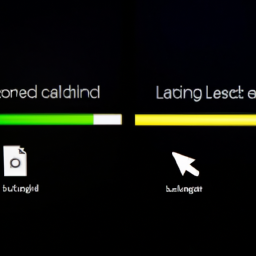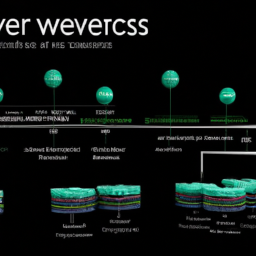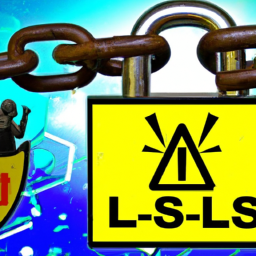Are you tired of waiting for webpages to load? Imagine a world where every website responds instantly, delivering information at the speed of thought. While this may sound like a hyperbole, it highlights the importance of diagnosing server response problems.
When users experience slow loading times or encounter errors, it can have a significant impact on their overall experience. As a website owner or developer, understanding the root cause of these issues is crucial for maintaining a seamless user experience.
By identifying common server response problems, such as high latency or server errors, you can take the necessary steps to address them. This article will guide you through the process of diagnosing these problems, implementing solutions, and ensuring ongoing maintenance and support.
So, let’s dive into the world of server response issues and learn how to optimize your website for optimal performance.
Key Takeaways
- Slow loading times and server errors negatively impact user experience
- Diagnosing server response problems promptly is vital to prevent erosion of customer loyalty and safeguard the brand’s reputation
- Implementing solutions like optimizing server configurations, upgrading hardware, and enhancing network infrastructure can address server response problems
- Regularly monitoring and testing server performance helps identify potential issues and vulnerabilities
Identify Common Server Response Problems
You should be aware of the common server response problems, as they can significantly impact the performance and accessibility of your website or application. Troubleshooting techniques are essential for identifying and resolving these issues promptly.
One common problem is slow response times, which can be caused by overloaded servers or inefficient code. This can lead to frustrated users and a decrease in overall performance.
Another issue is server errors, such as 500 Internal Server Error, which can occur due to misconfigurations or faulty scripts. These errors can negatively impact the user experience and even lead to lost business opportunities.
By understanding and addressing these server response problems, you can ensure that your website or application functions optimally, providing a seamless experience for your users.
Understand the Impact on User Experience
When users experience server response problems, it can lead to frustration and abandonment. Slow loading times or error messages can cause users to lose patience and abandon the website or application.
This can result in a negative perception of the brand, as users may associate the server response problems with poor performance or reliability. Ultimately, these issues can lead to decreased customer satisfaction, as users are less likely to return or engage with the brand in the future.
Frustration and Abandonment
Feeling overwhelmed and ready to give up? Diagnosing server response problems can help alleviate those frustrating moments and prevent you from throwing in the towel.
When users experience slow or non-responsive websites, it negatively impacts their overall experience, leading to frustration and potential abandonment. This can directly impact customer retention and ultimately, the revenue generated by your business.
By addressing server response problems promptly, you can minimize the chances of users getting frustrated and leaving your website. Here are five reasons why diagnosing these problems is crucial:
- Improved user satisfaction
- Increased customer loyalty
- Higher conversion rates
- Enhanced brand reputation
- Maximized revenue potential
When server response problems go unaddressed, they can lead to a negative perception of the brand. This can have long-lasting effects on your business, causing potential customers to view your brand in a less favorable light.
Negative Perception of the Brand
Experiencing slow or non-responsive websites can significantly impact user satisfaction and lead to a negative perception of the brand. When users encounter server response problems, it reflects poorly on the brand reputation and can result in customers losing trust and confidence in the company.
In today’s competitive digital landscape, where customer loyalty is crucial, a negative perception of the brand can have serious consequences. Users may choose to abandon the website and seek alternatives, damaging the company’s bottom line. Moreover, the negative experience can be shared with others, amplifying the damage to the brand’s reputation.
Therefore, diagnosing and resolving server response problems promptly is vital to prevent the erosion of customer loyalty and safeguard the brand’s reputation. By addressing these issues, companies can ensure a positive user experience and maintain customer satisfaction.
Decreased Customer Satisfaction
To truly understand the impact, imagine yourself navigating a website that’s slow and unresponsive, leaving you frustrated and dissatisfied with the overall experience. This is the reality for many customers when server response problems aren’t diagnosed and resolved promptly.
The consequences of decreased customer satisfaction are significant and can directly affect customer retention and revenue. Here are three reasons why:
-
Negative word-of-mouth: Unhappy customers are more likely to share their negative experiences with others, both online and offline. This can tarnish the brand’s reputation and deter potential customers from engaging with the company.
-
Decreased repeat purchases: Dissatisfied customers are less likely to return for future purchases. They may seek alternative solutions or switch to competitors who provide a smoother and more reliable online experience.
-
Lost revenue opportunities: When customers abandon their transactions due to slow or unresponsive servers, the company loses out on potential sales and revenue.
To address these issues and prevent further losses, it’s crucial to diagnose the root cause of the problem and take appropriate measures to resolve it. This will be discussed in the subsequent section about diagnosing the server response issues.
Diagnose the Root Cause of the Issue
Uncover the hidden thorns in your server’s performance that are pricking your website’s success. Diagnosing the root cause of server response problems is crucial in maintaining optimal customer satisfaction. By identifying potential solutions and troubleshooting network connectivity, you can pinpoint the underlying issues that are impacting your server’s performance.
This analytical approach allows you to delve into the intricate details of your server’s configuration, application performance, and network infrastructure. It involves analyzing server logs, monitoring network traffic, and conducting performance tests to uncover any bottlenecks or inefficiencies. By doing so, you can address the problem and implement solutions that will enhance your server’s response time, ensuring a seamless and satisfying user experience.
Transitioning into the subsequent section, addressing these issues will establish a solid foundation for improving customer satisfaction.
Address the Problem and Implement Solutions
By implementing effective solutions, you can untangle the knots and pave the way for a smoother server performance, ensuring a seamless user experience.
Implementing strategies such as optimizing server configurations, upgrading hardware, and enhancing network infrastructure can address the root causes of server response problems.
Evaluate the effectiveness of these solutions by closely monitoring server performance metrics, such as response time, throughput, and error rates. Conduct load testing to simulate heavy user traffic and identify potential bottlenecks.
Regularly review server logs and error messages to identify recurring issues and proactively address them. Additionally, consider implementing caching mechanisms, such as content delivery networks (CDNs), to offload server resources and improve response times.
By actively addressing server response problems and continuously evaluating the effectiveness of implemented solutions, you can ensure the smooth functioning of your server and deliver an optimal user experience.
Moving forward, it’s crucial to monitor and test regularly to maintain and improve server performance.
Monitor and Test Regularly
Regularly monitoring and testing server performance can help ensure its seamless functioning and improve user experience. By continuously monitoring the server, you can identify any potential issues or bottlenecks that may arise. This allows you to take proactive measures and implement performance optimizations to ensure smooth operation.
Regular testing also helps in identifying any potential vulnerabilities or weaknesses in the server, allowing you to address them promptly.
To emphasize the importance of continuous improvement and performance optimization, consider implementing the following nested bullet point list:
- Regularly monitor server response times and identify any slow or failing requests.
- Use tools like load testing to simulate high traffic scenarios and measure server performance under stress.
- Continuously optimize server configurations and settings to improve response times and reduce latency.
- Implement caching mechanisms, compression techniques, and load balancing strategies.
By regularly monitoring and testing your server, you can ensure ongoing maintenance and support while proactively addressing any potential performance issues that may arise. This helps to provide a seamless and efficient user experience.
Ensure Ongoing Maintenance and Support
Make sure to consistently maintain and provide support for your server to ensure its seamless operation. Ongoing server optimization is crucial for the smooth functioning of your website or application. Regular monitoring and maintenance activities, such as updating software, patching vulnerabilities, and optimizing server configurations, play a vital role in maximizing server performance. By actively addressing any server response problems and proactively identifying potential issues, you can minimize downtime and provide a better user experience. Additionally, ongoing maintenance and support contribute to customer retention strategies. When your server is reliable and efficient, it fosters customer trust and satisfaction, encouraging them to continue using your services. By prioritizing ongoing maintenance and support, you can ensure that your server is operating at its best and maintain a competitive edge in the market.
| Benefits of Ongoing Maintenance and Support | ||
|---|---|---|
| Minimizes downtime | ||
| Maximizes server performance | ||
| Enhances user experience | ||
| Fosters customer trust and satisfaction | Fosters customer trust and satisfaction by ensuring prompt resolution of issues and timely updates to meet their evolving needs. |
Frequently Asked Questions
How can I identify common server response problems?
To identify common server response problems, start by analyzing the HTTP status codes returned by the server. For example, let’s say you encounter a 500 Internal Server Error. This indicates a problem on the server side, such as a misconfigured application or insufficient resources.
Next, monitor the server logs for any error messages or anomalies. Additionally, perform load testing to identify any performance bottlenecks or server capacity issues.
By troubleshooting server response problems, you can ensure smooth and efficient website functionality.
What is the impact of server response problems on user experience?
Server response problems can have a significant impact on website performance and user experience. Slow server response times can lead to longer page load times, frustrating users and causing them to abandon the site. This can result in a decrease in traffic and conversion rates.
To optimize server response time, strategies such as caching, load balancing, and code optimization can be implemented. These techniques help to reduce latency and ensure faster and more efficient server responses, ultimately improving the overall user experience.
How do I diagnose the root cause of a server response issue?
To diagnose the root cause of a server response issue, start by identifying patterns in the problem. Analyze server logs, error messages, and network traffic to gather relevant data. Utilize troubleshooting techniques such as isolating the issue, testing different components, and checking configurations.
Use monitoring tools to track server performance metrics and identify any anomalies. By following these steps, you can effectively pinpoint the underlying cause of the server response issue.
What steps should I take to address and implement solutions for server response problems?
Addressing and implementing solutions for server response problems is like navigating through a treacherous maze. To address the issue, first identify the root cause by analyzing server logs and monitoring network traffic.
Then, optimize server configurations, upgrade hardware or software, and fine-tune code to improve response times. Implementing solutions involves deploying load balancers, caching mechanisms, and content delivery networks to enhance server performance.
This meticulous approach ensures efficient server response, enabling seamless user experiences and maintaining business productivity.
Why is it important to monitor and test server response regularly?
Regular monitoring and testing of server response is crucial for several reasons.
Firstly, proactive monitoring helps identify potential server response issues before they escalate into major problems. It allows you to detect any performance bottlenecks or slowdowns and take necessary action to optimize your server’s performance.
Load testing plays a vital role in this process by simulating real-world scenarios to evaluate the server’s ability to handle increased traffic and identify any weaknesses.
By regularly monitoring and testing server response, you can ensure optimal performance and prevent any potential downtime or user dissatisfaction.
Conclusion
In conclusion, diagnosing server response problems is crucial for maintaining a seamless user experience. By identifying common issues, understanding their impact, and pinpointing the root cause, you can effectively address the problem and implement solutions.
Regular monitoring and testing ensure that any potential issues are caught early on. Ongoing maintenance and support are essential for a well-functioning server. Just as a mechanic maintains a racing car, so must you maintain your server to keep it running smoothly.




















